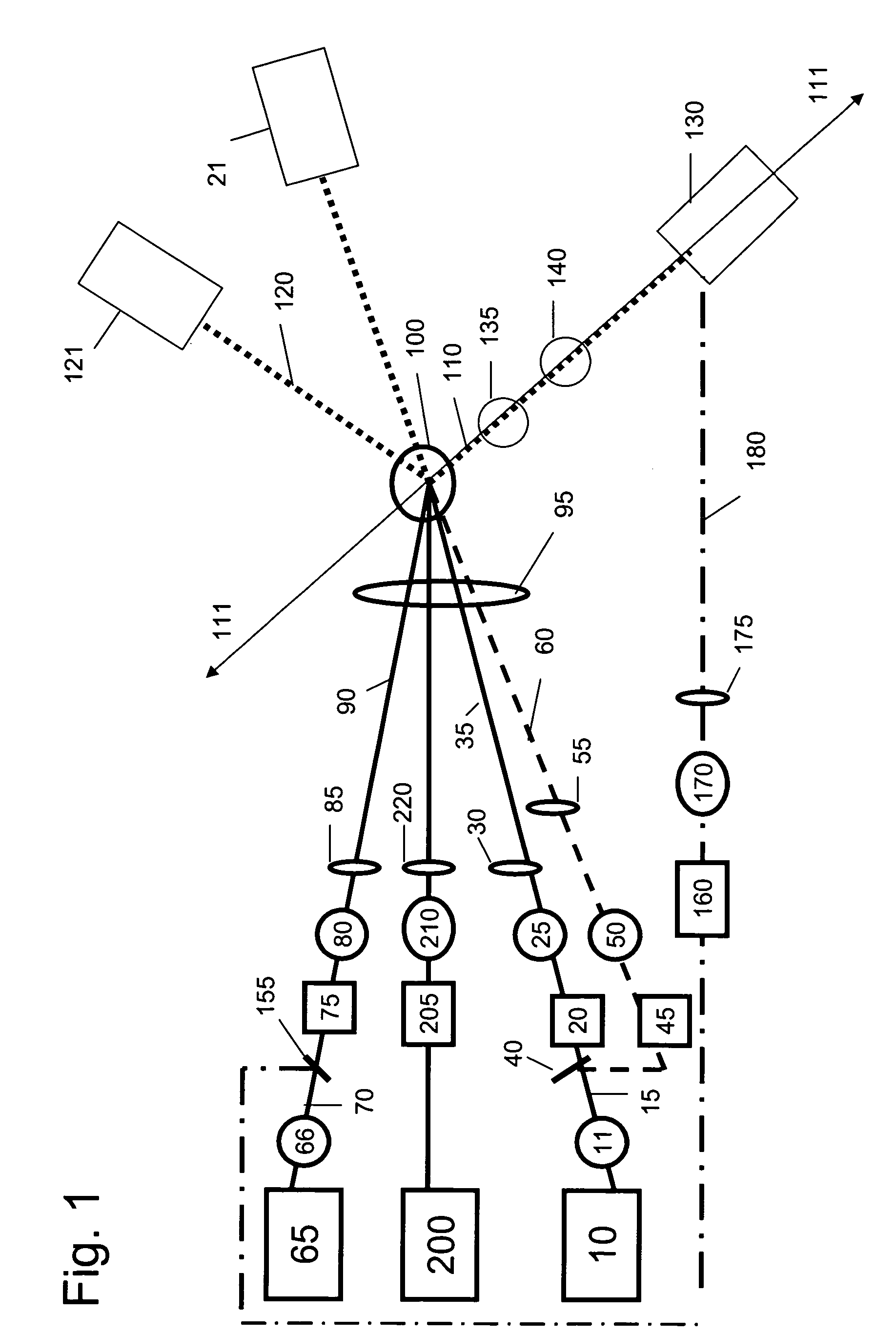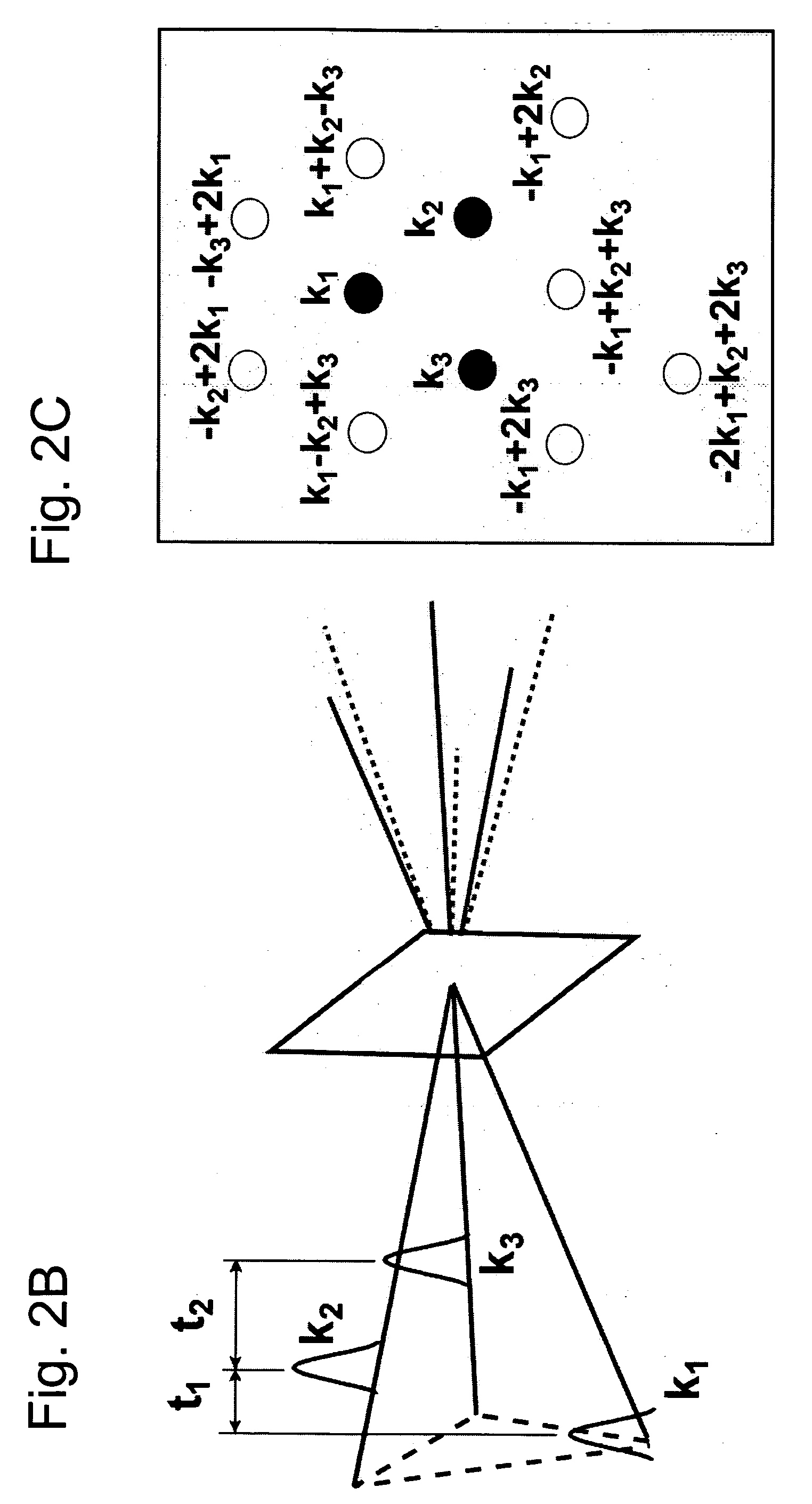[0032] An
advantage of vibrational tags useful in the present invention is that they typically, but do not have to, comprise small numbers (< about 4 atoms) of relatively small atoms (
atomic number < about 8), which have small, if any, effects on structure, reactivity and
biological activity, but have relatively large effects on the IR spectrum of the of molecules labeled with the vibrational tags, such as provide strong, new absorptions. This
advantage of the present invention is in contrast with fluorescent tags used in
fluorescence based
assay methods, which are typically much larger groups of atoms and thus, often have significant impacts on the structure, reactivity and
biological activity of molecules labeled with fluorescent tags.
[0033] Use of vibrational tags in the methods of the present invention is beneficial because it allows for coherent excitation of vibrational
modes of a target molecule, candidate molecule,
competitive binding reference molecule or any combination of these at
resonance frequencies that do not overlap significantly with the
resonance frequencies of other vibrational
modes of the target molecule, candidate molecule,
competitive binding reference molecule or any combination of these present in a sample undergoing analysis. In the context of one aspect of the present invention, with the proper choice of
resonance frequencies,
infrared pulse intensities, and
phase matching detection, use or absence of a heterodyned pulse, and concentrations of target, candidate molecule, competitive binder or vibrational tags, resonance frequencies that do not overlap significantly have oscillator strengths greater than or equal to as little as 1.01 times the oscillator strength of other overlapping resonance frequencies. Accordingly, vibrational tags in the present invention allow energy to be introduced into a sample undergoing optical analysis in a well controlled and pre-selected manner. For example, use of one or more vibrational tags may be used to selectively and coherently excite one or more vibrational
modes corresponding to one or more vibrational tags on a
protein or
peptide without significantly exciting other vibrational modes of the
protein or
peptide.
[0034] In one embodiment, methods of the present invention further comprise the steps of: (1) optionally providing a target molecule having a vibrational tag, (2) optionally providing a target molecule having a vibrational tag, (3) optionally providing a
competitive binding reference molecule having a vibrational tag; (4) selecting coherent light of the first
wavelength resonant with a vibration mode corresponding to a vibrational tag of a target molecule, candidate molecule and / or competitive binding reference molecule, and (5) optionally selecting coherent light of a second
wavelength resonant with a vibration mode corresponding to a vibrational of a target molecule, candidate molecule and / or competitive binding reference molecule.
[0035] In another aspect, the present invention provides methods of characterizing an interaction between a target molecule and a candidate molecule. In one embodiment, a method of the present invention comprises the steps of providing a target molecule and generating a first multidimensional
vibrational spectrum, such as a 2D IR spectrum, corresponding to experimental conditions of the target molecule in the absence of a candidate molecule. The target molecule is contacted with a candidate molecule and a second multidimensional
vibrational spectrum, such as 2D IR spectrum, is generated corresponding to experimental conditions of the target molecule in the presence of the candidate molecule. First and second multidimensional vibrational spectra, such as 2D IR spectra, are compared, for example by generating a 2D IR difference spectrum. Measurable differences in first and second multidimensional vibrational spectra, indicate the occurrence of an interaction(s) between target and candidate molecules and provide quantitative information regarding the fundamental nature of and
molecular dynamics involved with the interaction. For example, differences in first and second multidimensional vibrational spectra may be attributed to changes in the steric and / or electrostatic environments of specific, identifiable atoms that participate in vibrational motions corresponding to vibrational modes excited in target and candidate molecules. In one embodiment of the present invention, changes in first and second 2D IR spectra, such as shifts in the positions and intensity distributions of cross peaks and the appearance of new cross peaks, may be used to identify one or more regions of the target molecule, candidate molecule or both that participate in the interaction. This technique may also be used to probe the resulting structure of a molecular complex formed by associative interaction of the target molecule and candidate molecule. An
advantage of this method of the present invention is that it provides useful structural information relating to a target-candidate interaction, such as the localization, composition and structure of a binding region(s) of the target molecule and / or candidate molecule that is useful in assessing the biological importance of the interaction in a
drug discovery or optimization program.
[0036] In another embodiment, the present methods of characterizing an interaction between a target molecule and a candidate molecule comprise a method of determining the
binding constant,
dissociation constant or
equilibrium constant corresponding to an associative interaction between the target molecule and the candidate molecule. In one embodiment, a plurality of multidimensional vibrational spectra, such as 2D IR spectra, are acquired corresponding to experimental conditions wherein the concentration of the candidate molecule is selectively varied over a selected concentration range. This method of the present invention, further comprises the step of separately contacting the target molecule to various, selected concentrations of the candidate molecule and measuring a multidimensional
vibrational spectrum, such as 2D IR spectrum, corresponding to each candidate molecule concentration. In one embodiment, a plurality of difference spectra are determined by comparing the 2D IR spectrum corresponding to each candidate molecule concentration from a 2D IR spectrum corresponding to experimental conditions of the target molecule in the absence of the candidate molecule. An advantage of this method of the present invention is that it provides direct measurements of fundamental properties, such as binding constants and dissociation constants, that are useful for evaluating the
biological significance of an interaction and / or potential of a candidate molecule to provide a
lead compound in a
drug discovery or optimization program.
[0037] Multidimensional vibrational and electronic spectra, such as 2D IR spectra, useable in the present methods may be generated by any means known in the art of
infrared spectroscopy. “Ultrafast vibrational spectroscopy in condensed phase,” Phys. Chem. Comm., 2002, 5(7) p. 40-58,m by Minhaeng Cho and “Dual-frequency 2D-IR spectroscopy heterodyned
photon echo of the
peptide bond,” Proc. Natl. Acad. Sci. USA 2003 100 (10): 5601-5606, by Rubtsov et al., Golonzka O, Khalil M, Demirdöven N, Tokmakoff A. Phys. Rev. Lett. 2001, 86, 2154, “Experimental Determinations of Coherent Multidimensional Vibrational
Spectroscopy,” Bull. Korean Chem. Soc., 2003, Vol. 24, No. 8 1119-1125 by Besemann et al. and “Two-dimensional IR spectroscopy can be designed to eliminate the
diagonal peaks and
expose only the cross peaks needed for structure determination,”Proc. Natl. Acad. Sci. USA 2001, 98, 11265 by Zanni et al. provide descriptions of multidimensional vibrational
spectroscopy methods and means of generating multidimensional vibrational spectra, such as 2D IR spectra. These references are hereby incorporated by reference in their entireties. Means of generating multidimensional vibrational spectra, such as 2D IR spectra, useful in the methods of the present invention involve measurement of the time dependence
signal (e.g. intensity or amplitude of
electric field) of the
signal beam under experimental conditions corresponding to selective variation of the frequency of coherent of light delivered to a target containing sample, selective variation of the temporal properties of coherent pulses of
electromagnetic radiation delivered to a target containing sample, such as selective variation of
delay times between pulses of coherent
electromagnetic radiation, and / or selective variation of the polarization states of coherent light provided to a target containing sample. Exemplary means of generating multidimensional vibrational spectra, such as 2D IR spectra, useable in the present methods include
four wave mixing techniques and pump-probe methods including, but not limited to, two pulse
photon echo techniques, three pulse
photon echo techniques, heterodyned
four wave mixing techniques, homodyne four wave mixing techniques,
dual frequency heterodyned transient
grating techniques, frequency resolved four wave mixing techniques, spectrally resolved four wave mixing techniques,
pulse shaping four wave mixing techniques,
narrow band (
picosecond) four wave mixing techniques,
broad band four wave mixing techniques, time-gated four wave mixing techniques, and any version(s) of the above techniques with linearly or circular polarized pulses and temporally and / or
wavelength shaped pulses. The present methods also include techniques based on six-wave, eight-wave and higher variants are also included, as are variants that are not well described by a perturbative description or ones that include both n-wave and m-wave mixing where n and m are integers. It is well-known that many of the coherent, multidimensional vibrational and electronic processes and techniques referred to above have incoherent analogues. Description of coherent multidimensional techniques in the present methods is by way of example, and incoherent analogues of these techniques are also useful for carrying out the methods of the present invention. Accordingly, the present invention includes all variations of the present methods wherein incoherent analogues are substituted for the coherent, multidimensional techniques and processes described and referred to in this description.
 Login to View More
Login to View More 


